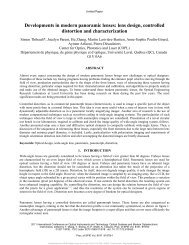Multi-task single lens for automotive vision applications - LRIO
Multi-task single lens for automotive vision applications - LRIO
Multi-task single lens for automotive vision applications - LRIO
You also want an ePaper? Increase the reach of your titles
YUMPU automatically turns print PDFs into web optimized ePapers that Google loves.
• Road sign detection and recognition:<br />
o Large FoV to detect road signs at different locations<br />
o 0.5-meter sign width must cover 12 to 24 pixels wide<br />
• Blind zone avoidance:<br />
o Large FoV: Larger than 180° to avoid blind zones<br />
o Projection algorithms to rectify the image and provide a user-friendly view to the driver<br />
4.1 Field-of-view (FoV) of the application<br />
Each application listed above needs a large field-of-view (FoV), so a wide-angle <strong>lens</strong> is required. Depending on the<br />
tolerances in the <strong>lens</strong> position, a FoV of up to 190° is required to guarantee a full hemispheric FoV. There are different<br />
types of wide-angle <strong>lens</strong>es, as the author has explained in a previous paper 9 . Mirror imager and PAL are not studied due<br />
to inappropriate fit-<strong>for</strong>m-function factors (i.e. the blind zone in the middle of the FoV). In this case study, the authors<br />
will consider only fisheye and panomorph <strong>lens</strong>es, and will demonstrate the benefits of the panomorph <strong>lens</strong> utilization.<br />
4.2 Lens distortion, anamorphosis and resolution<br />
Fisheye <strong>lens</strong>es have a radial distortion across the hemispherical field-of-view (FoV). The radial distortion of the fisheye<br />
<strong>lens</strong> depends on the design itself, and introduces some variation in the resolution (pixels/degrees) over the entire FoV.<br />
This variation can be quantified as a departure from the ideal theoretical fisheye <strong>lens</strong>, which has a theoretical linear (ftheta)<br />
mapping. According to Kumler and Bauer 11 , different types of fisheye <strong>lens</strong>es have different per<strong>for</strong>mances<br />
regarding the departure of perfect linear (f-theta) mapping, which can go up to 16%, especially along the border (20 last<br />
degrees). The panomorph <strong>lens</strong> uses distortion as a design parameter, in order to provide high-resolution coverage in a<br />
specific zone of interest. For this academic exercise, we will consider the “theoretically perfect” fisheye <strong>lens</strong> with 190°<br />
FoV and 0% departure (linear resolution), and a panomorph <strong>lens</strong> with 190° FoV and an adapted resolution (distortion).<br />
Fisheye <strong>lens</strong>es produce a circular footprint on the sensor. Fisheye <strong>lens</strong>es don’t have any anamorphosis. Panomorph<br />
<strong>lens</strong>es produce an elliptical footprint on the sensor. The anamorphic design of the panomorph <strong>lens</strong> provides a<br />
customizable coverage of the sensor. Depending on the mechanical and assembly tolerances, the panomorph <strong>lens</strong> is<br />
designed to ensure that the footprint fits into the sensor, using small border merges. For this academic exercise, we will<br />
choose a 4/3 sensor and the border merges will be negligible.<br />
A panomorph <strong>lens</strong> can be used with any sensor <strong>for</strong>mat (VGA, XGA, SXGA etc.) as long as the <strong>lens</strong> per<strong>for</strong>mance<br />
matches the Nyquist frequency of the sensor. For this academic exercise, we chose a 1.2 mega pixel sensor (1280 x 960<br />
pixels) called a target sensor.<br />
A collision warning application needs to have at least 10 pixels to define a two-meter wide object (vehicle). As defined<br />
by Thibault 12 , a fisheye <strong>lens</strong> is 5.04 pixels/degree on the targeted sensor (1280*960) over the entire FoV.<br />
(1)<br />
Size<br />
α =<br />
Re sP<br />
Where Size p is the object size on the sensor in pixels, and Re sP / ° is the resolution of the system <strong>lens</strong>-sensor in<br />
pixels/degree: A 10-pixel object represents a α=1.98° FoV and a 40-pixel object represents a α=7.9 FoV.<br />
Sizem<br />
(2)<br />
d =<br />
Tan(α<br />
)<br />
Where Size m is the object size in meters: A 10-pixel object is d=57.8 meters from the car. This means that a two-meter<br />
wide object will illuminate 10 pixels or more when the objects are within 57.8 meters.<br />
p<br />
/ °<br />
Proc. of SPIE Vol. 7314 731409-8<br />
Downloaded from SPIE Digital Library on 10 Jun 2011 to 132.203.118.98. Terms of Use: http://spiedl.org/terms



